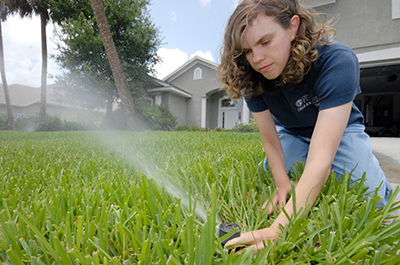Saving Water Using Your Irrigation System

Water is becoming an increasingly scarce natural resource, and it should be used as efficiently as possible. Knowing the amount of water your sprinkler system applies to your lawn is an important step in efficient water use.
What Are Irrigation Zones?
An automatic, underground irrigation system breaks down the job of watering your lawn into smaller areas called “zones.” Each of these zones covers a specific area of your yard. Usually there are four or more zones per lawn.
Irrigation systems should be zoned separately for turf and ornamental plants, since water requirements differ for the two. This should be fairly straightforward if you have planting beds.
Ornamental plants should be grouped according to their water requirements: water-loving plants should be grouped separately from drought-tolerant plants. This allows for the proper amount of water to be distributed to the plants as they need it.
What Do I Need for an Automatic Sprinkler System?
An automatic sprinkler system consists of two basic components: a controller and an irrigation shut-off device (a rain sensor or a soil-moisture sensor, more likely the former). A controller is a timing device that controls the frequency and length of time that the system runs. A rain sensor prevents unnecessary irrigation during and soon after a rainfall. Soil-moisture sensors prevent unnecessary irrigation if there is sufficient moisture in the soil.
Rain sensors, which are required by law on all irrigation systems, are available in several models and are usually connected to the automatic irrigation system remotely or by wiring. The device overrides a scheduled or occurring irrigation after a certain amount of rainfall has occurred, by sensing moisture in the soil.
What Are the Benefits of Irrigation Shut-off Devices?
Irrigation shut-off devices like rain sensors are a low-cost way to save water in your landscape. These devices detect when a certain amount of rain has fallen, and they make sure your automatic irrigation system doesn’t run when it’s not needed.
All new irrigation systems are required by law to include a rain or soil-moisture sensor. Your sensors should always be functioning correctly, so check them regularly.
Rain sensors conserve water, save you money, and reduce wear on your irrigation system. They can also help prevent turf disease and other problems caused by excess moisture. While rain sensors react only to rainfall, soil-moisture sensors can still be useful in times of drought by detecting excess irrigation and limiting irrigation cycles accordingly. Read “Residential Irrigation System Rainfall Shut-off Devices” for further information.
What Does “Calibrating My Sprinkler System” Mean?
Calibrating your sprinkler system means figuring out how long you need to run the system to apply the correct amount of water. For most Florida soils, the correct amount is 1/2 to 3/4 inches of water. This rate varies depending on your location in the state. Heavier clay soils, such as in North Florida and the panhandle, may only need the 1/2-inch rate. In sandy soil, which doesn’t hold water as long, you may need to apply the 3/4-inch rate.
How Do I Calibrate My System?

Set out five to ten coffee or tuna fish cans (any straight-sided can will do) around your lawn. If you have an in-ground irrigation system with multiple zones, place the containers in one zone at a time. Scatter the cans at random within the zone. Repeat the procedure in every zone, because there may be differences in how uniformly water is applied in each zone.
If you use a hose-end sprinkler to water your turf, place the cans in a straight line from the sprinkler to the edge of the watering pattern. Space the containers evenly.
Turn on the sprinkler system for fifteen minutes. Then use a ruler to measure the depth of water in each container. The more precise your measurement, the better your calibration will be.
Find the average depth of water collected in the containers. To do this, add up the depths in the different containers and divide that number by the number of containers. This will give you the correct rate in inches per fifteen minutes.
To determine the irrigation rate in inches per hour, multiply the above number times four.
When Is the Best Time to Irrigate?
Early morning is the best time to irrigate (4 a.m. to 8 a.m.). It is cool enough for water to soak into the soil and be absorbed by roots, but it will soon be warm enough for excess moisture to evaporate off the leaf blades. Water that remains on the blades for long periods of time can actually cause turf diseases, so irrigating at night is not a good idea. However, if you cannot irrigate at the ideal time, it’s better to irrigate at night than between 10 a.m. and 4 p.m. Irrigating during this time will waste water because most of it will evaporate without reaching the roots.
Also on Gardening Solutions
- Calibrating Your Irrigation System
- Lawn Management During Drought
- Protecting Florida’s Water Resources
- Rain Gauges and Rain Sensors
- Setting Your Irrigation Timer
- Water Conservation
